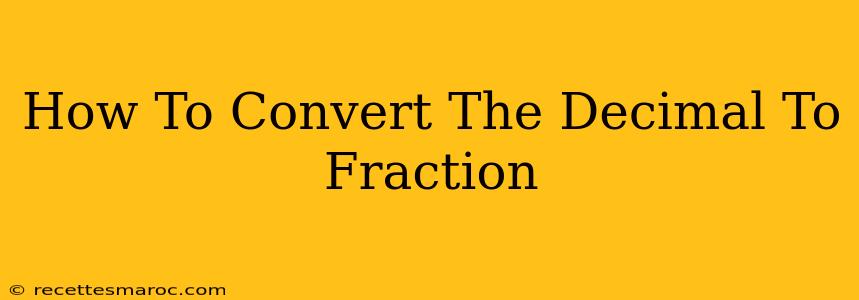Converting decimals to fractions might seem daunting at first, but it's a straightforward process once you understand the underlying principles. This guide will walk you through the steps, providing clear examples and tips to master this essential math skill. Whether you're a student tackling homework or an adult needing to refresh your knowledge, this guide is for you.
Understanding Decimal Places
Before we begin, let's refresh our understanding of decimal places. The numbers to the right of the decimal point represent tenths, hundredths, thousandths, and so on. For example:
- 0.1 represents one-tenth (1/10)
- 0.01 represents one-hundredth (1/100)
- 0.001 represents one-thousandth (1/1000)
This understanding is crucial for converting decimals to fractions.
Step-by-Step Guide to Decimal to Fraction Conversion
Here's a step-by-step guide to help you convert any decimal to a fraction:
Step 1: Write the decimal as a fraction with a denominator of 1.
This is the first and most crucial step. Let's say we want to convert the decimal 0.75 to a fraction. We start by writing it as:
0.75/1
Step 2: Multiply both the numerator and the denominator by a power of 10.
The power of 10 you choose depends on the number of digits after the decimal point. For each digit after the decimal, add a zero to 10.
Since 0.75 has two digits after the decimal point, we multiply both the numerator and denominator by 100:
(0.75 x 100) / (1 x 100) = 75/100
Step 3: Simplify the fraction.
This step involves finding the greatest common divisor (GCD) of the numerator and denominator and dividing both by it. The GCD of 75 and 100 is 25. Dividing both by 25 gives us:
75/100 = 3/4
Therefore, 0.75 as a fraction is 3/4.
Examples of Decimal to Fraction Conversion
Let's look at a few more examples to solidify your understanding:
Example 1: Converting 0.2 to a fraction
- Write as a fraction: 0.2/1
- Multiply by 10: (0.2 x 10) / (1 x 10) = 2/10
- Simplify: 2/10 = 1/5
Example 2: Converting 0.625 to a fraction
- Write as a fraction: 0.625/1
- Multiply by 1000: (0.625 x 1000) / (1 x 1000) = 625/1000
- Simplify: 625/1000 = 5/8
Example 3: Converting 0.333... (repeating decimal) to a fraction
Repeating decimals require a slightly different approach. We won't delve into the detailed method here, but it's important to note that repeating decimals often translate to fractions involving repeating digits. For example, 0.333... is equivalent to 1/3.
Tips and Tricks for Success
- Practice regularly: The more you practice, the more comfortable you'll become with the process.
- Use online calculators: Several online calculators can help you convert decimals to fractions quickly and accurately.
- Understand simplification: Simplifying fractions is crucial to obtain the correct answer. Mastering finding the GCD will greatly improve your accuracy.
By following these steps and practicing regularly, you'll master the skill of converting decimals to fractions. Remember, understanding the underlying principles is key to success in mathematics!

